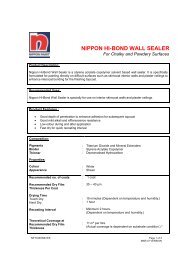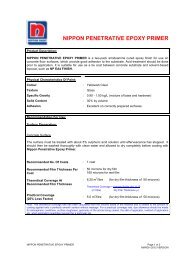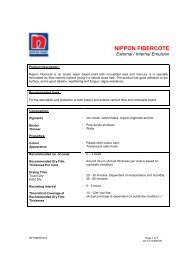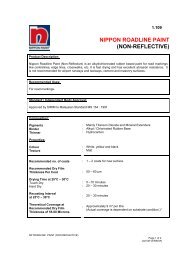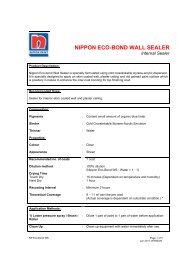Indoor Air Quality - Nippon Paint Malaysia
Indoor Air Quality - Nippon Paint Malaysia
Indoor Air Quality - Nippon Paint Malaysia
You also want an ePaper? Increase the reach of your titles
YUMPU automatically turns print PDFs into web optimized ePapers that Google loves.
• Technology Oriented • Business Driven • Sustainable Development • Environmental Friendly<br />
Result<br />
Table 3.2 Comparison of<br />
indoor air pollutant<br />
parameters between old<br />
and new buildings<br />
Temperature<br />
recorded above<br />
suggested standard<br />
regulated by DOSH<br />
Parameters New Old Statistic p-value<br />
Mean SD Mean SD<br />
Formaldehyde (ppm) 0.071 0.16 0.051 0.16 1.061 0.289<br />
TVOCs (ppm) 0.032 0.12 0.020 0.20 0.515 0.606<br />
Temperature ( 0 C) 26.37 3.88 26.74 3.30 -0.801 0.425<br />
Relative Humidity (%) 64.50 8.36 61.08 8.78 3.233* 0.001<br />
<strong>Air</strong> Movement (m/s) 0.110 0.16 0.141 0.99 -0.233 0.816<br />
Carbon Dioxide (ppm) 587.1 192.9 600.7 315.2 -0.383 0.702<br />
Result – Explanation<br />
• High formaldehyde in new buildings = new structure more hazardous<br />
compared to old buildings in most of Klang Valley areas (but, old<br />
buildings have inefficient MVAC systems = therefore formaldehyde<br />
was still captured during our investigation<br />
• Formaldehyde is influenced by the temperature, RH and ventilation



